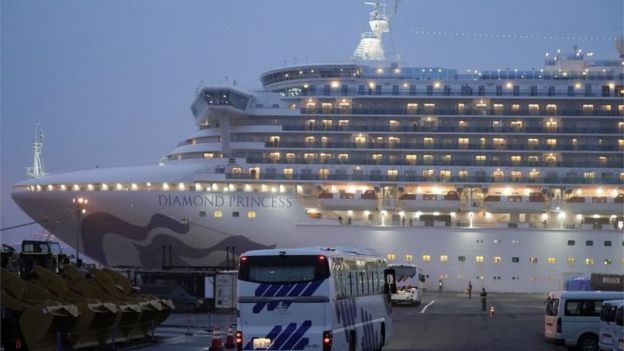Coronavirus: Study Suggests Elderly and Sick Most at Risk

Health
officials in China have published the first details of more than 44,000 cases
of Covid-19, in the biggest study since the outbreak began.
Data from
the Chinese Centre for Disease Control and Prevention (CCDC) finds that more
than 80% of the cases have been mild, with the sick and elderly most at risk.
The research
also points to the high risk to medical staff.
A hospital
director in the city of Wuhan died from the virus on Tuesday.
Liu Zhiming,
51, was the director of the Wuchang Hospital in Wuhan - one of the leading
hospitals in the virus epicentre. He is one of the most senior health officials
to die so far.
Hubei, whose
capital is Wuhan, is the worst affected province in the country.
The report
by the CCDC shows the province's death rate is 2.9% compared with 0.4% in the
rest of the country.
The findings
put the overall death rate of the Covid-19 virus at 2.3%.
China's
latest official figures released on Tuesday put the overall death toll at 1,868
and 72,436 infections.
Officials
reported 98 new deaths and 1,886 new cases in the past day, with 93 of those
deaths and 1,807 infections in Hubei province - the epicentre of the outbreak.
More than
12,000 people have recovered, according to Chinese authorities.
While the
results largely confirm previous descriptions of the virus and patterns of
infection, the study includes a detailed breakdown of the 44,672 confirmed
cases across all of China.
It finds
that 80.9% of infections are classified as mild, 13.8% as severe and only 4.7%
as critical. The number of deaths among those infected, known as the fatality
rate, remains low but rises among those over 80 years old.
Pointing out
the risk to medical staff, the paper says that a total of 3,019
health workers have been infected, 1,716 of which were
confirmed cases.
Five had died by 11 February, which was the last day of
data included in the research.
On 13
February, China broadened its definition of how to diagnose people, including
"clinically diagnosed cases" which previously were counted separate
from "confirmed cases".
This is by
far the most detailed study of the coronavirus outbreak within China. It gives
us incredible insight into what is happening, but the picture is far from
complete.
You can
study only the cases you find, and other scientists have estimated there could
be 10 times as many people infected as are ending up in the official
statistics. That means the overall death rate is likely to be lower than the
one reported in this study.
The report
also suggests the outbreak peaked in late January, but it is too soon to know
for sure.
What this
analysis clearly describes is a "highly contagious" virus that
spreads "extremely rapidly" even in the face of an "extreme
response" by China.
That should
be a warning to the rest of the world.
Looking
forward, the paper finds that "the epidemic curve of
onset of symptoms" peaked around 23-26 January before
declining up to 11 February.
The study
suggests that the downward trend in the overall
epidemic curve could mean that "isolation of whole
cities, broadcast of critical information (e.g., promoting hand
washing, mask wearing, and care seeking) with high frequency through
multiple channels, and mobilization of a multi-sector rapid
response teams is helping to curb the epidemic".

But the
authors also warn that with many people returning from a long holiday, the
country "needs to prepare for the possible rebound of the epidemic".
China's
response to the virus has seen the lockdown of Wuhan - the largest city in
Hubei - and the rest of the province as well as severe travel restrictions on
movements across the country.
The virus
has spread beyond mainland China to countries around the globe and two cruise
ships are now confirmed to have been affected.
The Diamond
Princess was quarantined in the Japanese port of Yokohama on 3 February, after
a man from Hong Kong tested positive. More than 450 of the 3,700 people on
board have since become infected.
On Tuesday
South Korea joined the list of the countries and territories also planning to
get their residents out which already includes Canada, Australia, the UK,
Israel and Hong Kong.
A second
ship, the MS Westerdam, was turned away by multiple ports around Asia over
fears it could be carrying the virus.
It was
finally cleared to dock in Sihanoukville, Cambodia, after no cases were found
on board. Disembarking passengers were personally welcomed by Prime Minister
Hun Sen. No one was quarantined.
However,
days later, a woman who had been on the ship tested positive after arriving in
Malaysia. Huge efforts are now being made to track down the passengers, who
have moved on to many different countries including Malaysia and Thailand, but
also further afield to the US and Canada.
Several
countries have said they will not admit foreign visitors who were on the ship.
There are
still 255 guests and 747 crew on board the MS Westerdam, while more than 400
passengers have been sent to a hotel in the Cambodian capital, Phnom Penh, to
await test results.
FROM .bbc.com/news/world-asia-china-

No comments